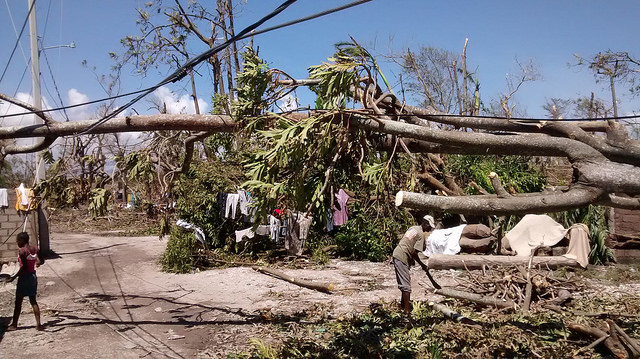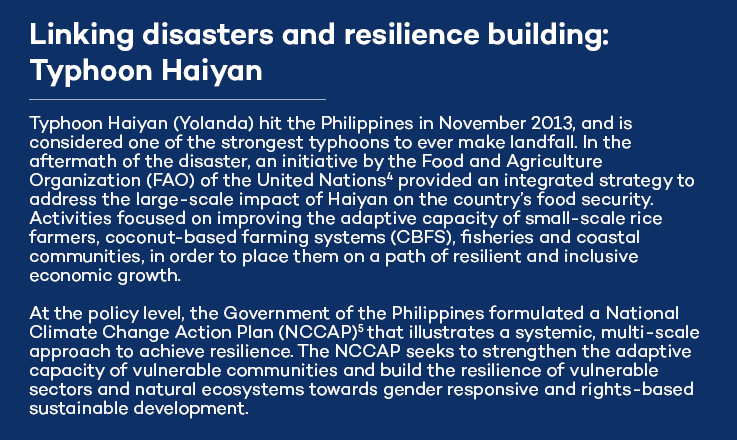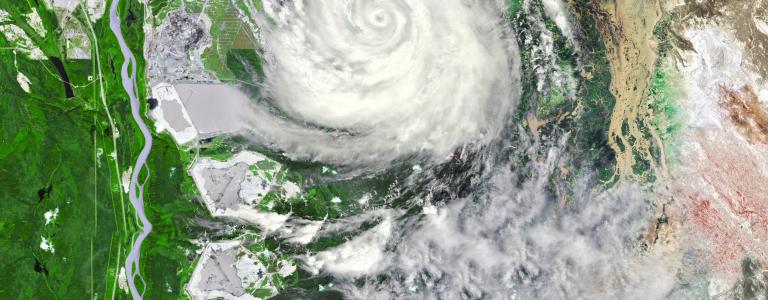Hurricane Matthew: What role for resilience building?
As the international development community, national and local stakeholders join efforts to respond to storms, a focus on resilience building can be useful in four key ways,
Striking images of Hurricane Matthew’s trail of devastation in the Caribbean region continue pouring in, as the storm makes its way through the U.S. eastern coast.
Messages, pictures and videos shared through social media tell a well-known, yet heartbreaking story: the shattering impacts of disasters on communities that are still struggling to overcome the effects of previous crises—of the last earthquake, the last hurricane, the last food crisis or health epidemic.
In Haiti, the effects of Hurricane Matthew will almost certainly exacerbate pre-existing challenges, remnants of the 2010 earthquake that left more than 1.5 million homeless and that resulted in a grave humanitarian crisis.[1]
The story of a hurricane sweeping the region is not only one about immediate physical devastation, documented in ‘real-time.’ The story is deeper and more far-reaching, particularly in terms of human and socio-economic development. It is a story about the impacts of disasters on livelihood options, on opportunities and the well-being of vulnerable communities—in the short, medium and long term. For these communities, the ability to cope with and adapt to change is not optional, but rather imperative to survival.
Hurricane Matthew has impacted vulnerable contexts where the compounded effects of shocks and long-term stressors are evidence of the importance of resilience building.

Photo: Julien Mulliez/DFID via Flickr
As the international development community, national and local stakeholders join efforts to respond to the storm, a focus on resilience building can be useful in four key ways:
Strengthening the capacity to recover, but also to leap forward
Building resilience is about strengthening the capacity of vulnerable systems to absorb, adapt, and potentially transform amidst change and uncertainty. It highlights the need to focus on post-disaster relief and transitional needs (e.g. shelter, food), but also on strengthening resources and attributes that will allow affected communities to improve and leap forward: to ‘bounce back better,’ in other words.[2] Institutional robustness, the ability of communities to self-organize and learn from past experiences, to access diversified livelihoods and participate meaningfully in recovery processes, are a few of the attributes that play a role in resilience building.[3]
Integrating multiple scales
Resilience requires the adoption of a holistic, integrating perspective that considers the local (household, community and municipal), regional, national and international levels. Cross-scale integration will play a fundamental role in Hurricane Matthew’s response efforts, as strategies should build upon new and existing multi-sectoral collaboration, synergies, local knowledge and institutional strengths.

Embracing flexibility in programs and strategies
Resilience building takes place in complex, dynamic systems. In vulnerable developing contexts, characterized by constant change and uncertainty, resilience requires flexible programming and adaptive management. For stakeholders involved in hurricane response efforts, this translates into the ability to revise, learn and adapt their activities, to ensure the relevance of programs and strategies in regards to emerging needs and priorities in the ground.
Focusing on the long-term process, not on ‘quick wins’
Resilience building is a long-term process, not a stand-alone technical solution. It requires development stakeholders to adopt a long-term perspective, fostering activities that are articulated with broader development goals. In the aftermath of a hurricane, this translates into not losing sight of the ‘big picture,’ and focusing on sustainable growth.
Hurricane Matthew will continue its trajectory, and new, perhaps stronger hurricanes will hit again the already fragile communities that stand at the forefront of their effects. Resilience thinking provides us with an opportunity to examine vulnerable contexts under a new, deeper and more comprehensive lens, and to identify what can we do to provide the relief needed today, to achieve the sustainable growth of tomorrow.
Angelica V Ospina is a senior researcher with IISD's Resilience Program.
[1] https://www.oxfam.org/en/haiti-earthquake-our-response
[2] DFID, (2011) Defining Disaster Resilience: A DFID Approach Paper. The Department for International Development, London.
[3] Coles, Eve and Buckle, Philip. Developing Community Resilience as a Foundation for Effective Disaster Recovery. Australian Journal of Emergency Management, Vol. 19, No. 4, Nov 2004: 6-15.
[4] FAO (2015) Typhoon Haiyan: Portraits of Resilience, Food and Agriculture Organization of the United Nations, Manila, http://www.fao.org/3/a-i5177e.pdf
[5] Philippines National Climate Change Action Plan 2011-2018, Climate Change Commission, http://faolex.fao.org/docs/pdf/phi152934.pdf
You might also be interested in
Sustainable Asset Valuation of Parques del Río Norte in Medellín, Colombia
This economic valuation demonstrates the benefits of expanding urban green space in the city of Medellín, Colombia.
What’s Next After UNEA-6: Why “synergies” is more than a buzzword
In an era marked by escalating environmental challenges and geopolitical tension, the Sixth United Nations Environment Assembly (UNEA-6) called for more cooperation to tackle the triple planetary crisis.
UNFCCC Submissions Tracker
Tracking and sharing opportunities for stakeholders to give input to the UN climate change negotiations.
The State of Global Environmental Governance 2023
In global environmental talks in 2023, the focus across nearly all issue areas was funding implementation and reviewing performance.
